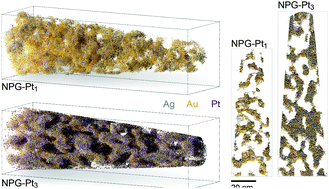Nanoscale mechanism of the stabilization of nanoporous gold by alloyed platinum†
Abstract
Nanoporous gold (NPG) is usually made by electrochemical dealloying of Ag from binary AgAu alloys. The resulting nanoscale ligaments are not very stable, and tend to coarsen with time by surface self-diffusion, especially in electrolyte, which may lead to inferior electrocatalytic properties. Addition of a small amount of Pt to the precursor alloy is known to refine and stabilize the nanoporous product (NPG-Pt). However, the mechanisms by which Pt serves to refine the microstructure remain poorly understood. The present study aims to expand our knowledge of the role of Pt by examining NPG-Pt at atomic resolution with Atom Probe Tomography (APT), as well as by aberration-corrected Transmission Electron Microscopy. Atomic level observation of Pt enrichment on ligament surfaces sheds light on the underlying mechanisms that give rise to Pt's refining effect. Owing to improved Ag retention with higher Pt content, NPG-Pt1 (made by dealloying Ag77Au22Pt1) was shown to have the highest surface area-to-volume ratio, compared to NPG-Pt3 (made by dealloying Ag77Au20Pt3). Quantitative estimates reveal up to 5-fold enrichment of Pt at nanoligament surfaces, compared to the precursor content, in NPG-Pt. The interface between the dealloyed layer and the substrate was captured by APT, for the first time. The findings of this investigation add insight into the functionality of NPG-Pt and its prospective catalytic performance.



 Please wait while we load your content...
Please wait while we load your content...